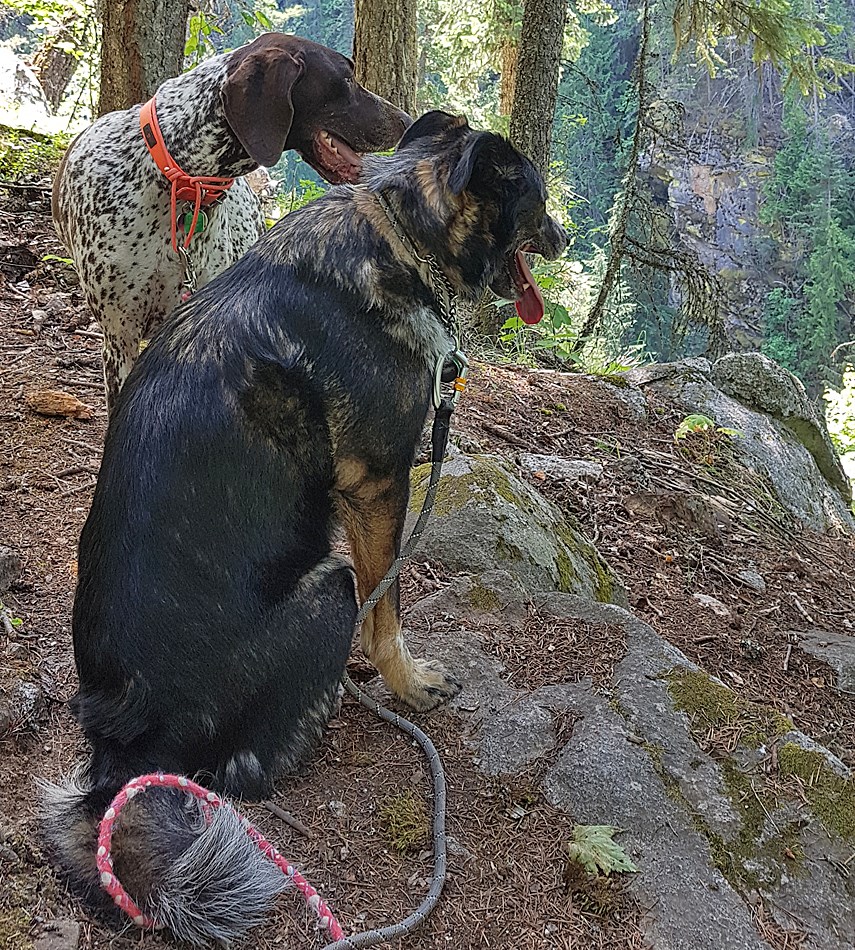It was just after 7 a.m. when I sat down at an outdoor café in Sicamous, B.C.
It was going to be a hot day and I wanted to get an early start on the three-hour hike I had planned with my dogs into the canyon. The café was understandably quiet at this time of the day and I could have my dogs on the patio with me instead of in the truck.
I placed my dogs in their wait command and treated myself to a fabulous café au lait.
The wait command is a versatile and valuable training tool and is considered a foundation obedience exercise. The wait command is meant to teach your dog to remain in place.
A dog can sit, stand, lie down and turn around, it just cannot leave the spot. It is a foundation exercise because it is a command that is also used to control and shape behaviours both wanted and unwanted. It is also used to teach impulse control, patience and confidence plus assist with desensitization, socialization and setting boundaries.
It can also be used to get some great Instagram shots!
Teaching the wait is not difficult, but it does require proper timing, patience and a leash. Leashes offer control, which allow for better focus and consistency on both the dogs and owners part, which in turn creates a better learning environment.
Start the training with a handful of treats. Leash your dog, then drop the leash and step on it. You want the leash to be short enough that the dog cannot take a step, but long enough that it can change positions comfortably, then say the command “wait.”
Now the hard part – be patient.
You are starting to shape the dogs behaviour and are waiting for the dog to stop fussing and choose a calm position on its own without being encouraged by you. Your dog may choose to sit, lie down or stand but the goal is to wait for your dog to relax into whatever position it chooses. The moment it does this you mark the behaviour with the word “Yes” then immediately give the treat. Reinforce the command by repeating six more times.
Next, pick up your leash, remove your foot and say “All done” and release your dog from this spot. Then go and find another area and start again. Vary your training places so that your dog does not associate one particular place as the “waiting spot.”
After about six or so repetitions end the training for the day.
The next day, repeat the previous day’s training exercise a couple of times to see how your dog has retained the information. Once you have determined that your dog has remembered what it was taught, increase the challenge.
With treats in your hand and your dog on leash, drop the leash and step on it. As before, when your dog relaxes give them the “wait” command, reward with a treat and praise your dog. Then reinforce the command by saying “good wait” and give a treat.
Now take one step away from your dog. Your dog should remain in their spot. Do not stay away from them too long as they may interpret this as a signal to come to you. In this step you are beginning to build their confidence and self control with you at a distance, so take one step away, pause for a breath, then calmly return to them and reward with a treat. Then pick up the leash, verbally praise your dog, give them the ‘all done’ command and walk away with your dog. If your dog breaks the position and comes to you during the wait, just remain calm and reposition your dog where they were and start again, but this time don’t go so far away from your dog. They are not ready for you to be that far away from them.
Each time you practice this, take steps further away from your dog and remain at a distance from them for longer periods of time. But be patient because it is hard for your dog to see you at a distance and not want to be with you. Their confidence and self-control is built slowly.
Once you can remain at a distance from your dog without them moving, then you can begin to add greater distractions like practicing it in the yard, or a park.
Take the time to teach your dog the wait command and add another tool to your training belt. In the process you will build their confidence, self control and create a trustworthy dog that you can bring into any situation.
Joan Klucha has been working with dogs for more than 20 years in obedience, tracking and behavioural rehabilitation. Contact her at [email protected].



